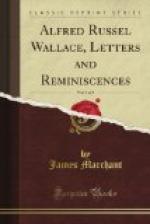ALFRED R. WALLACE.
* * * * *
Down, Bromley, Kent, S.E. October 12 and 13, 1867.
My dear Wallace,—I ordered the journal a long time ago, but by some oversight received it only yesterday and read it. You will think my praise not worth having from being so indiscriminate, but if I am to speak the truth, I must say I admire every word.
You have just touched on the points which I particularly wished to see noticed. I am glad you had the courage to take up Angraecum[62] after the Duke’s attack; for I believe the principle in this case may be widely applied. I like the figure, but I wish the artist had drawn a better sphinx.
With respect to beauty, your remarks on hideous objects and on flowers not being made beautiful except when of practical use to them strike me as very good.
On this one point of beauty, I can hardly think that the Duke was quite candid. I have used in the concluding paragraph of my present book precisely the same argument as you have, even bringing in the bulldog,[63] with respect to variations not having been specially ordained. Your metaphor of the river[64] is new to me, and admirable; but your other metaphor, in which you compare classification and complex machines, does not seem to me quite appropriate, though I cannot point out what seems deficient. The point which seems to me strong is that all naturalists admit that there is a natural classification, and it is this which descent explains. I wish you had insisted a little more against the North British[65] reviewer assuming that each variation which appears is a strongly marked one; though by implication you have made this very, plain. Nothing in your whole article has struck me more than your view with respect to the limit of fleetness in the racehorse and other such cases; I shall try and quote you on this head in the proof of my concluding chapter. I quite missed this explanation, though in the case of wheat I hit upon something analogous. I am glad you praise the Duke’s book, for I was much struck with it. The part about flight seemed to me at first very good, but as the wing is articulated by a ball-and-socket joint, I suspect the Duke would find it very difficult to give any reason against the belief that the wing strikes the air more or less obliquely. I have been very glad to see your article and the drawing of the butterfly in Science Gossip. By the way, I cannot but think that you push protection too far in some cases, as with the stripes on the tiger. I have also this morning read an excellent abstract in the Gardeners’ Chronicle of your paper on nests;[66] I was not by any means fully converted by your letter, but I think now I am so; and I hope it will be published somewhere in extenso. It strikes me as a capital generalisation, and appears to me even more original than it did at first.




